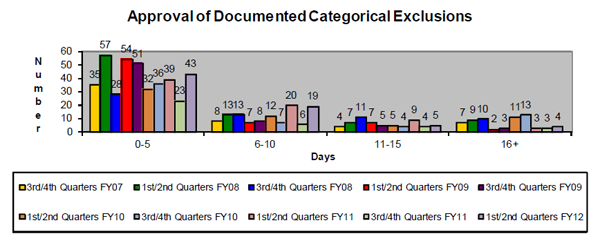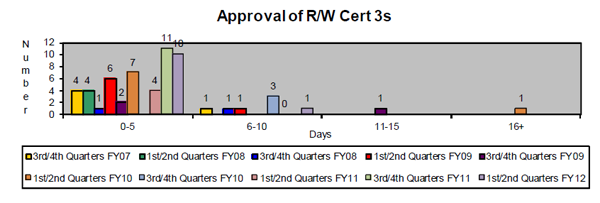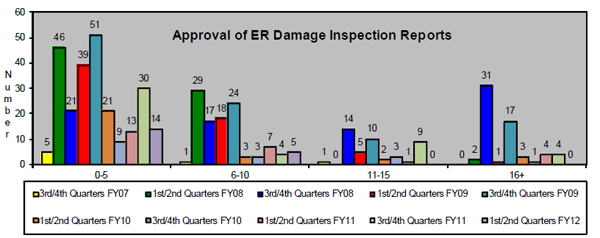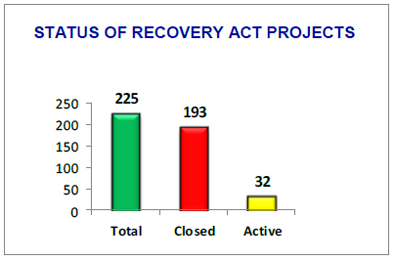U.S. Department of Transportation
Federal Highway Administration
1200 New Jersey Avenue, SE
Washington, DC 20590
202-366-4000
Washington Division
The Federal Highway Administration (FHWA) Washington Division (WADIV) has developed the following Project Delivery Report which highlights some of the broad array of activities / initiatives / approvals we perform to assist the Washington State Department of Transportation (WSDOT) and local agencies in delivering projects.
Federal Highway Administration (FHWA) and the Washington State Department of Transportation (WSDOT) executed a Memorandum of Understanding (MOU) on the use of Agency Forces on November 3, 2010.
The MOU establishes a two year evaluation program on the use of Agency Forces for Federal-Aid projects in Washington.
Since October 2010, 48 projects have used agency forces for at least some of the work on Federal-Aid contracts. The total value of work done by agency forces on these 48 jobs is approximately $7.7 million.
Agency forces have been used on 36 local agency jobs and 12 WSDOT jobs across all the Regions and one Washington State ferry project.
The Washington Division has done several activities to further streamline the delivery of the Emergency Relief (ER) Program in Washington State.
The Division has conducted ER webinar training for WSDOT and local officials with well over 200 participants and provided training sessions to WSDOT's Regions on the 2009 ER Manual changes. Also, the Division developed, recorded, and posted six (6) ER training modules on our office website: https://www.fhwa.dot.gov/wadiv/emerrelief/
Additional guidance was developed and distributed on several ER Program areas such as betterments and temporary and permanent repairs. Also, endangered species act (ESA) compliance for ER projects has been streamlined by expanding the application of the 4(d) maintenance rule to include Federally- funded projects.

This chart shows the timeliness of approval of documented categorical exclusions (DCEs) semi-annually from FY2007 to FY2012.
As the chart depicts, we are approving the vast majority of DCEs within the first 10 days of receipt.

This chart shows the timeliness of approval for right-of-way (R/W) Certifications 3 (Cert. 3s)
Certifications that took longer than 10 days required negotiations that took additional time to finalize.
| * | Approval of certifications 1 and 2 have been delegated to WSDOT. |
| ** | In order to authorize the advertisement of a project for construction, the State must certify the R/W has been cleared, per 23 CFR 635.309. |
| *** | Certification 3s are to be used only in very unusual circumstances. |
| Number of Days | 1999 | 2000 | 2001 | 2002 | 2003 | 2004 | 2005 | 2006 | 2007 | 2008 | 2009 | 2010 | 2011 | 2012 |
|---|---|---|---|---|---|---|---|---|---|---|---|---|---|---|
| 0 to 5 Days | 208 | 780 | 858 | 724 | 1327 | 1463 | 1456 | 943 | 1451 | 1645 | 2261 | 1936 | 1791 | 848 |
| 6 to 10 Days | 24 | 241 | 307 | 121 | 90 | 101 | 103 | 68 | 175 | 128 | 113 | 131 | 41 | 7 |
| 11 to 15 Days | 12 | 77 | 109 | 39 | 10 | 22 | 24 | 13 | 37 | 12 | 7 | 18 | 7 | 0 |
| 16 to 20 Days | 9 | 29 | 34 | 21 | 5 | 3 | 8 | 1 | 18 | 5 | 1 | 3 | 2 | 0 |
| 20 + Days | 31 | 152 | 68 | 98 | 52 | 15 | 17 | 8 | 16 | 13 | 5 | 1 | 0 | 0 |
| Totals | 284 | 1279 | 1376 | 1003 | 1484 | 1604 | 1608 | 1033 | 1697 | 1803 | 2387 | 2089 | 1841 | 855 |
This table reflects the number of authorizations / modifications approved within certain timeframes since 2000.
(Note: the FY begins on October 1 and ends on September 30 of the following year.)
The Washington Division worked with WSDOT, the Department of Archaeology & Historic Preservation (DAHP) (also the State Historic Preservation Officer (SHPO)) and the US Forest Service (USFS) to execute a second statewide Programmatic Agreement (PA) for Washington. This January 2012 agreement complements the 2007 statewide PA for streamlining Section 106 review. This new agreement is focused on streamlining Section 106 consultations for Federal-Aid Highway projects that occur on Forest Service lands.
For projects crossing USFS lands, the USFS is required to authorize the use of right-of-way for the project in the form of a "consent for appropriation" of federal land. In such cases, the agencies have agreed that FHWA is the lead federal agency for completion of Section 106.
In order to streamline review, the PA identifies undertakings that have "minimal potential to cause adverse effects to historic properties." Certain undertakings do not require Section 106 review by the SHPO or Forest Service Heritage Program Manager provided background research indicates that there are no known historic properties or eligible resources in the area of potential effects that could be affected by the undertaking, and low potential for unknown resources.
Undertakings that may be exempted from further review include actions such as roadway surface replacement, installation of traffic control devices, in-kind emergency repairs, rock removal and stabilization activities, and use of previously disturbed areas for temporary construction staging. A separate list includes WSDOT activities that are also exempted from SHPO review, but require coordination with the Forest Service Heritage Program Manager to determine the appropriate level of identification.
This is the only statewide PA in the country specifically developed to address FHWA undertakings on federal lands. It may serve as a model for other states with a similar need to clarify roles and responsibilities, and to expedite routine projects. With little risk of causing inadvertent damage to historic sites, the PA should save WSDOT, FHWA, and USFS considerable time and money in processing minor projects with no historic properties affected.

This chart shows the timeliness of approval for emergency relief (ER) damage inspection reports. Our goal is to approve 90% of these reports within 10 days of receipt.
The chart to the right shows the current status of the American Recovery & Reinvestment Act (Recovery Act) projects in Washington State as of May 31. 193 of the 225 projects have been completed and closed with 44 remaining active.
Also of note, of the $491,252,853 available to Washington State, a total of $490,463,038 or 99.8% has been obligated and 98.7% has been spent.
Although about half of the Recovery Act projects have been final vouchered ("closed") nationwide (as of May 31), Washington State leads the country with 86% of its projects closed!

| Dan Mathis Division Administrator FHWA Washington Division 360-753-9480 Daniel.Mathis@dot.gov |
Yamilée P. Volcy SW and Eastern Regions Area Engineer FHWA Washington Division 360-753-9552 Yamilee.Volcy@dot.gov |
 |